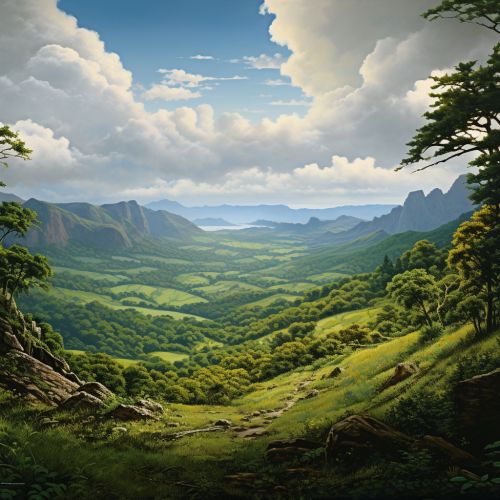Appalachian Mountains
Geography and Geology
The Appalachian Mountains, often simply referred to as the Appalachians, are a vast system of mountains in eastern North America. The range is predominantly located in the United States but extends into southeastern Canada, forming a zone from 150 to 500 kilometers wide running nearly 3,000 kilometers from the island of Newfoundland in the northeast to central Alabama in the southeast.
The Appalachians are among the oldest mountains on Earth, born of powerful upheavals within the terrestrial crust and sculpted by the ceaseless action of water upon the surface. The two types of rock that characterize the present Appalachian ranges tell much of the story of the mountains' long existence. The igneous and metamorphic rocks that form the bulk of the Appalachian Mountains from the southeast to the northwest were once buried many kilometers beneath the surface of the Earth. The pressure and heat of burial altered the texture and composition of these rocks in a process known as metamorphism.


Ecology and Biodiversity
The Appalachian region is home to a rich and diverse array of flora and fauna. The range's diverse topography and geology contribute to its high biodiversity. The region is recognized as one of the world's richest temperate deciduous forests, with the southern Appalachians particularly rich in endemic species. The Appalachians are home to over 200 species of trees, more than any other North American mountain range. The region's rich biodiversity is also reflected in its variety of fauna, which includes over 300 species of birds and numerous species of mammals, reptiles, and amphibians.
Human History and Culture
The human history of the Appalachian Mountains is a story of both cultural adaptation and cultural diffusion. The first known inhabitants of the Appalachians were the Paleo-Indians, who arrived in the region around 10,000 BC. Over the centuries, various indigenous cultures inhabited the region, including the Cherokee and Shawnee tribes.
With the arrival of European settlers in the 16th and 17th centuries, the indigenous cultures of the Appalachians underwent significant changes. The settlers brought with them new technologies, plants, animals, and diseases, which had profound impacts on the indigenous cultures. The settlers also introduced new forms of social organization and land use, which led to significant changes in the cultural landscape of the Appalachians.
Economy
The Appalachian region has a diverse economy, with significant contributions from various sectors including agriculture, mining, manufacturing, and services. The region's rich natural resources have played a significant role in shaping its economic history. The Appalachians have been a major source of timber and coal for the United States. The region is also known for its rich cultural heritage, including traditional music, crafts, and foodways, which contribute to the local economy through tourism and the arts.
See Also
Geology of the Appalachians Flora of the Appalachian Mountains History of the Appalachian people
